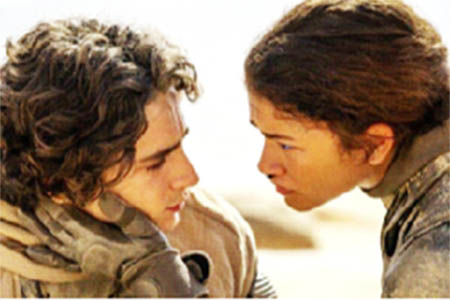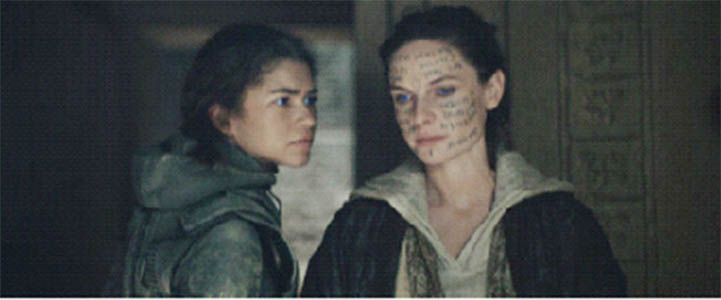
The central crises are established early on. Paul Atreides (Timothee Chalamet) insists on becoming one with the Fremen to the frustration of his mother Jessica (Rebecca Ferguson) who is eager for Paul to take on his prophesied role of saviour to the Fremen. The Fremen have heard stories, for years, of a mother and a son from an outer world destined to bring prosperity to Arrakis, and its people. Stilgar (Javier Bardem), a Fremen tribal leader, is inclined to believe this while Chani (Zendaya) a Freman warrior is more sceptical. Elsewhere, the Bene Gesserit Reverend Mother (Charlotte Rampling) is exploring other options for power now that the Atreides have proved unhelpful. Her top alternative is Feyd-Rautha Harkonnen (Austin Butler), the younger brother of the current steward of Arrakis, Rabban Harkonnen (Dave Bautista). The person-to-person intrigue is high here, with richer plot developments than the first part, but even when interpersonal intrigue is at its peak “Dune: Part Two” is marching onwards to its steady refrain – this is a bleak world where these characters are merely incidental in a larger cosmic rot that colours everything around them.

There are numerous scenes in “Dune: Part Two” where the camera traps the faces of the character in sharp close-ups, but when my memory tries to bring specific tableaus to the fore
I tend to think of the characters shot from afar. Two lovers, on a mountain of sand, whispering to each other. Two men, fighting to the death, as a malevolent crowd jeers them on. Soldiers floating in the sky. It makes sense for my mind to linger on these moments of humans rendered smaller against the largeness of the landscape. It’s natural, for a film about a fight for a land. It’s also part of a thread of harrowing determinism that washes over a lot of “Dune: Part Two”. The characters ostensibly provide the emotional beats for the story, but they are cogs in the wheel of the brutal inevitability of the world they inhabit. Each gesture, each inclination carries the weight of a certain bleak future.
One of the most effective technical aspects of “Dune: Part Two” which feels central to its philosophical weight is the editing from Joe Walker which takes on the rhythms of montage even when the film is not performing montage. The weight of the inevitable is rendered most literally in the visions from Paul, and Jessica who ascends to a respected role as the Fremen’s own Reverend Mother. Jessica’s ascendancy, after drinking the Water of Life, awakens the mind of her unborn daughter who she speaks of with increasing fervour. The visual presentation of the visions in “Dune: Part Two” provide an instructive context for this world. Rather than being markedly removed from the aesthetics of the “real” world, the visions and dreams feel just as grounded in the same austere remoteness of the film’s world. The cadence of the real sequences in the film bleed into each other, giving them the capricious energy that occurs in the way a dream might. A bleak dream. Time feels both too fast, and too slow, as if the entire world is weighed down by the inevitability of the future. It’s a weight that “Dune: Part Two” is perceptive about, and Villeneuve and his creative team have taken to heart. “Dune: Part Two” feels heavy – the very air that surrounds the character makes every whispered conversation, or private wince feel loaded with every oppressive note of music promising tension.

It is the vastness of this world that is prioritised, not the people. In a world of such inevitability, the actors are given a hard task that they, mostly, rise to. Villeneuve makes explicit attempts to ground the middle section in a humanistic compulsion resting on the relationship between Paul and Chani. Chalamet and Zendaya have warm, if not quite fiery, chemistry that helps although both feel less confident in their work than their peers. In the major adaptation change for the film, Villeneuve has turned Chani into the sceptic of the world and it’s a decision that offers Zendaya a chance to put her contemporary affect to good use. Better performances come from Ferguson, whose turn towards fanaticism is helped by a fiercely committed performance, and from Javier Bardem whose blind-faith feels tragic and familiar. You can see how much Austin Butler relishes the thrill of playing his deranged psychopath and it’s a turn that plays well with others especially in brief moments opposite Lea Seydoux as a member of the Bene Gesserit.
Despite its nominal lead in Paul, the sprawling ambivalence of this space future feels more aligned with the dynamics of an ensemble film. It’s an unease that feels closest to the despair flowing through characters in Villeneuve’s “Prisoners”.
Whereas in “Prisoners”, though, entire sequences in the film felt imitative of the performers themselves and their characters (Jackman’s righteous fury, Dano’s inveigling anxiety, Gyllenhaal’s stolid scepticism) the performances in “Dune: Part Two”, all feel rendered secondary to the scope and weight of the planets they live on. There are people here, but more than people there are places and buildings and sand, endless sand. By the end of the film when Paul makes fateful decision after fateful decision on the way to an assured tragic end, the compulsive decay of this world seems assured.
Villeneuve’s bleak outlook will not find favour with many, but I’m impressed by his resistance to contextualising or explaining much of the meaning here. This might seem like a weakness for some, but instead I find myself intrigued at how the rhythms of “Dune: Part Two” take for granted our ability to make sense of the religious logic. It feels as if we are dropped into a world existing for years on its own. The political and religious weight of this world are presented as matter-of-fact realities, and this solemn approach to it – as if it were a Cecil De Mille epic, but bleaker – adds weight to the drama even when individual elements do not quite coalesce. We take the events here with operatic seriousness, all the way to their bitter end.




